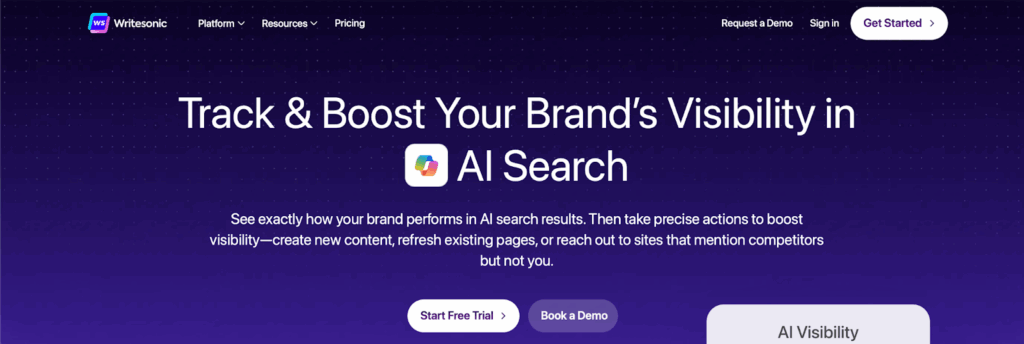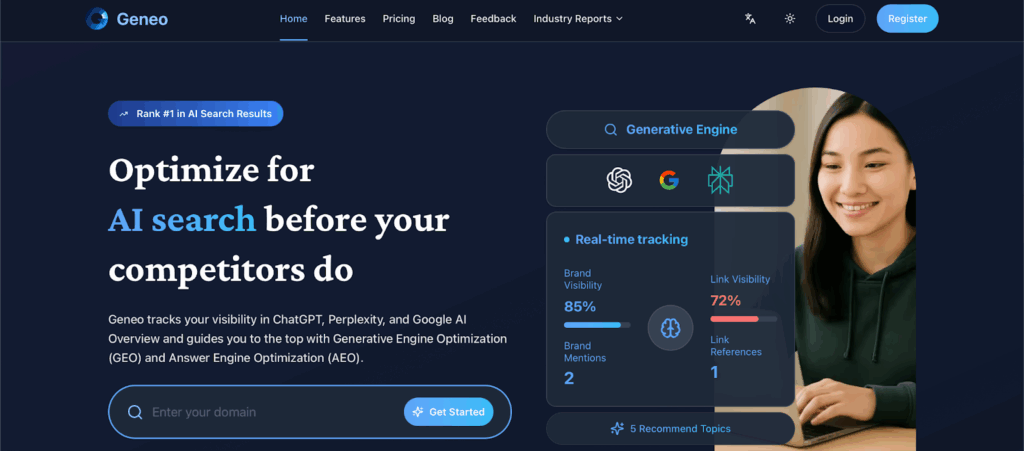Top GEO tools are transforming how businesses reach customers in 2025. Generative engine optimization is rapidly replacing traditional SEO.
Gartner predicts traditional search engine volume will drop by 25 % by 2026 as users shift to AI assistants. Organic search click-through rates can fall by 34 percent when AI provides answers.
AI-driven traffic also compresses the buyer journey, reaching decision points faster. That means, for marketing agencies, CEOs, and business owners, adopting top GEO tools is crucial to maintain brand authority.
This guide will explore GEO workflows, AI schema markup, writing for AI, and zero-click content strategies. It also covers real-world examples and actionable steps to boost results. So, let us dive into your complete arsenal for 2025.
Why GEO Matters in 2025
GEO vs SEO? Well, GEO is the new SEO. Traditional SEO focuses on backlinks, keywords, and index-based ranking. GEO focuses on meaning, context, citations, and LLM discovery.
AI citations are replacing conventional backlinks as authority signals. Writing for AI and optimizing content for a zero-click content strategy improves visibility in generative AI engines.
GEO content aligns with user intent and allows brands to appear in AI-generated answers. Businesses leveraging GEO for e-commerce gain middle-to-bottom funnel conversions faster.
Generative engine optimization ensures content is cited, recommended, and trusted by AI. ChatGPT users spend more time browsing multiple pages per session than Google users. CEOs and business owners need GEO workflows to stay competitive in AI-first marketing.
Companies that adopt GEO strategies also report better brand authority, faster decision-making, and stronger ROI. According to Statista, the market for AI technologies is massive, valued at approximately 244 billion U.S. dollars in 2025. Analysts project it will grow to over 800 billion dollars by 2030, highlighting the enormous opportunity for businesses to leverage GEO workflows, AI schema markup, and generative engine optimization.
Top 11 GEO Tools for Your Business

Top GEO tools provide automation, citation tracking, and content optimization for AI engines. Using the right tools simplifies generative engine optimization and strengthens brand authority.
Here are essential tools for 2025:
- GEO Content Planner Tools to map content for AI discovery and zero-click strategy.
- AI Citation Trackers to monitor mentions across generative engines and GEO platforms.
- Schema Markup Generators to simplify AI schema markup implementation for structured data.
- Generative Engine Optimization Dashboards to track AI-driven content performance in real time.
- Content Distribution Platforms for AI discovery, such as LinkedIn, YouTube, and Quora.
Popular AI marketing tools like Jasper AI, Surfer SEO, and Semrush AI integrate with GEO workflows. These tools prevent GEO mistakes, manage AI citations, and maintain brand authority.
And, CEOs can track results with dashboards and actionable insights to optimize zero-click content strategies. For example, Shopify uses AI-powered dashboards to track product mentions and optimize e-commerce GEO content.

Writesonic is an AI-powered writing assistant built to turn data-rich insights into accessible, engaging content.
For GEO teams, it means converting location-based analytics into blog posts, reports, or summaries in minutes, while staying SEO-optimized and regionally relevant.
• Generates localized reports, blog posts, and marketing copy from geospatial input.
• Built-in SEO-optimization helps surface content tied to regional keywords and trends
• Saves time by automating repetitive content tasks and enabling non-writers to create professional output.
• Ideal for GEO analysts, marketing teams and organizations producing frequent updates.

Otterly.AI is a specialized platform designed to help brands track and improve how they appear within AI‑driven search experiences like ChatGPT, Perplexity, Gemini and Microsoft Copilot. In addition, It’s built around the concept of Generative Engine Optimization (GEO)—optimizing for being cited, referenced or surfaced within generative answers, not just ranked in a traditional search engine.
Key Capabilities:
- Tracks your brand mentions, link citations and domain visibility across AI‑search platforms.
- Provides a GEO Audit that reviews 25+ on‑page factors affecting your ability to be cited in AI answers.
- Offers prompt‑based keyword research to identify the conversational queries users make to LLMs, turning them into content opportunities.
- Compiles weekly reports and alerts on changes in brand visibility, link citations or competitor performance in the AI‑search space.
3.. Rankscale

Rankscale offers a practical GEO‑toolset for analyzing how content is cited in AI responses, simulating prompts, and helping teams rank in AI‑generated answers.
- Simulates large language model responses, testing how prompts trigger your brand content.
- Provides page‑level visibility tracking: how many times your site appears in generative engine citations.
- Helps identify content gaps and prompts you need to update to gain better AI visibility.
- Ideal for analytics teams who want to track their performance in LLM‑driven answer panels.
4. Geneo.app

Geneo.app is positioned as a GEO pioneer, offering real‑time visibility tracking across models like ChatGPT, Perplexity and Google AI Overviews.
• Monitors your brand’s citations and appearances in AI‑generated responses
• Provides competitive benchmarking for AI visibility in generative engines
• Helps you pivot your content strategy based on prompt performance and AI‑source usage
5. Qwairy

Qwairy offers an all‑in‑one GEO suite, combining visibility tracking, content optimization and prompt simulation for AI search environments.
• Tracks brand mentions, sentiment and link‑citations across LLMs
• Includes audits to assess how your content is interpreted by AI
• Simplifies GEO workflows with dashboards built for non‑technical users
6. BrandRank.ai
BrandRank.ai specialises in brand‑level GEO performance: monitoring how your brand appears in generative answers, tracking visibility share and alerting on drop‑offs.
• Brand mention tracking across ChatGPT, Gemini, Claude, etc.
• Sentiment and narrative alignment monitoring (how AI describes you)
• Competitor brand visibility comparison in generative search
7. Profound

Profound is an enterprise‑grade GEO platform with deep analytics, log‑level data, full AI engine API coverage and measurement integration.
• Tracks AI answer engine citations, prompt emulation, even product/sku visibility
• Integrates server‑side measurement for AI‑driven conversions and outcomes
• Offers compliance features, multi‑region coverage and high‑scale workflows
8. Scrunch AI

While known for brand and social intelligence, Scrunch AI has extended into GEO by tracking how content and brand narratives are represented by LLMs.
• Monitors brand stories in AI‑generated answers and flags mis‑representations
• Helps brands maintain authority and correct inaccurate citations in AI responses
• Useful for reputation + GEO combined focus
9. Ziptie
Ziptie offers AI visibility monitoring and page‑level GEO insights for smaller teams.
• AI Success Score: shows how likely your page is shown in LLM responses
• Basic prompt panels and competitor tracking for GEO visibility
• Lower cost option if you’re starting GEO workflows
10. Xfunnel AI

Xfunnel AI focuses on conversion & funnel optimisation around generative engine visibility; how content surfaces in AI influences downstream actions.
• Monitor AI‑driven query flows, from prompt to outcome
• Blend GEO visibility data with conversion metrics (e‑commerce, lead gen)
• Helps content teams tie AI visibility to business outcomes
11. LLMO Metrics
LLMO Metrics specialises in multi‑model coverage (ChatGPT, Claude, Gemini, Perplexity) and detailed page‑level tracking of AI citations across engines.
• Tracks number of times a URL is referenced by AI engines
• Provides alerts when your brand’s share shifts in AI answers
• Good balance of affordability + GEO‑specific functionality
Enhancing GEO Performance with Integrated Tools
Optimizing your brand’s presence across generative AI platforms requires a strategic approach. Initially, businesses should audit existing content and track current AI visibility. Furthermore, using citation trackers ensures your brand is referenced accurately, while schema markup generators simplify structured data implementation.
In addition, content distribution platforms like LinkedIn and YouTube amplify reach, thus increasing the likelihood of being surfaced in AI answers. Similarly, dashboards and analytics tools provide actionable insights, allowing teams to adjust content strategies in real time. Consequently, integrating AI marketing tools such as Jasper AI or Surfer SEO streamlines workflows, whileminimizing errors. Moreover, automated reporting keeps stakeholders informed, and predictive insights guide proactive optimizations. Therefore, combining these tools into a cohesive GEO workflow strengthens brand authority, improves visibility, and ensures measurable ROI. Finally, by continuously refining processes, teams can adapt to evolving AI algorithms and maintain competitive advantage.
Key Steps for GEO Optimization:
- Conduct a Content Audit: Initially, identify gaps, strengths, and underperforming pages to understand current AI visibility. Subsequently, prioritize content for optimization.
- Monitor Brand Citations: Furthermore, use citation trackers to maintain accuracy, thus reinforcing authority across generative engines.
- Implement Structured Data: In addition, schema markup generators help AI interpret your content correctly, ensuring better discoverability.
- Distribute Strategically: Similarly, sharing AI-optimized content on platforms like LinkedIn or YouTube enhances reach, while engaging target audiences effectively.
- Analyze Performance: Consequently, dashboards allow real-time tracking, and predictive metrics guide adjustments for continuous improvement.
- Automate and Streamline Workflows: Moreover, tools like Jasper AI or Surfer SEO save time, while ensuring content remains regionally and SEO-optimized.
- Iterate for Growth: Finally, combine insights from all tools to refine strategies, thereby maximizing visibility, engagement, and ROI.
The Four Pillars of GEO Success
Pillar one is Authority Signals. High authority backlinks, original research, expert authorship, and trust signals increase AI citation rates.
Then, pillar two is Content Structure. Use FAQ formats, clear heading hierarchy, front-loaded key information, and provide quotable statistics.
To continue, pillar three is Technical Optimization. Implement AI schema markup, allow GPTBot and CCBot access, and optimize page speed and mobile responsiveness.
Pillar four is Strategic Distribution. Engage on platforms AI engines scan, including Reddit, Quora, LinkedIn, YouTube, Wikipedia, G2, and Capterra.
Following these pillars ensures GEO success and maximizes generative engine optimization. Brands like HubSpot integrate all four pillars for content discovery by AI, generating higher engagement rates.
How to Get Cited by AI Engines
Optimizing content for AI citations requires clear action.
- Produce original research or proprietary data.
- Structure content with headings and FAQ sections.
- Implement AI schema markup for articles, FAQs, and products.
- Obtain authority signals such as expert authorship and backlinks.
- Distribute content on platforms that AI engines index, including review sites and forums.
So, this checklist improves chances of appearing in zero-click results. Business owners can track citation performance using top GEO tools and dashboards.
For example, Canva uses structured AI content to appear in multiple ChatGPT prompts, improving brand recognition and trust.
Common GEO Mistakes to Avoid
Businesses often make GEO mistakes that reduce effectiveness.
Avoid shallow content that AI cannot understand.
Do not ignore AI schema markup or structured data.
Maintain consistent citations across platforms.
Do not rely solely on traditional SEO without GEO integration.
Ensure content is distributed where AI engines can crawl.
Focusing on SEO to GEO transition ensures content is optimized for AI. Writing for AI and adopting GEO workflows prevents lost opportunities. So, companies that address these issues maintain brand authority and engagement.
Therefore, mistakes like inconsistent citations can reduce trust signals and limit your content’s reach across generative AI engines.
Quick Check: Is GEO Right for Your Business

You are ready for GEO if:
- You have a budget for six month growth initiative.
- You are investing in content marketing and SEO.
- Your products or services are searched through AI.
- You notice traffic shifts or zero-click growth.
- Leadership supports adopting new channels.
You are not ready if:
- SEO basics are not solid.
- Content production is inconsistent.
- Your website is hard to navigate.
- You cannot commit to six months.
Proper readiness ensures your investment in GEO workflows, AI schema markup, and AI citations yields tangible results.
Practical GEO Implementation for CEOs and Business Owners
Begin by auditing existing content for AI discoverability. Then, add AI schema markup and produce GEO content optimized for generative engine optimization.
Following, track AI citations using top GEO tools. Monitor engagement and adjust content to maintain relevance. Integrating GEO workflows compresses the buyer journey and improves brand authority.
Companies like HubSpot and Shopify have successfully applied AI-driven content distribution and citation strategies. So, CEOs can follow these steps to gain measurable results.
Internal linking within your website, linking to product pages or blog posts, enhances AI content context. External links to authority sources like Gartner and Statista strengthen AI citations.
GEO Content for E-commerce Success
GEO for e-commerce drives higher conversion rates by targeting AI users ready to purchase. LLM-driven traffic often represents middle to bottom funnel users.
Thus, using top GEO tools, businesses can create GEO content optimized for product discovery. And, AI schema markup ensures product details appear in generative engine results.
Zero-click content strategy highlights product answers directly, reducing friction and increasing trust. Hence why, businesses like Amazon and Shopify implement AI citations and GEO workflows to maintain brand authority.
Strategically distributing product content on forums, YouTube, and review sites improves discoverability. Proper GEO implementation enhances ROI, reduces bounce rates, and builds long-term customer engagement.
Three Key Takeaways: The Shift Is Real
AI searching is growing 113 % year over year.
GEO has a clear framework with four pillars. Also, the roadmap is ready for execution.
So, start implementing today to capture AI-driven traffic. And, partner with Azarian Growth Agency to integrate top GEO tools and generative engine optimization. Maximize zero-click content strategies and elevate brand authority.
Conclusion
Top GEO tools are essential for modern business growth.
So, GEO content, AI citations, AI schema markup, and generative engine optimization improve visibility, engagement, and conversions.
Therefore, it’s best to avoid GEO mistakes and follow the four pillars of GEO success. CEOs and marketing leaders can integrate GEO workflows to optimize content for AI and gain brand authority.
Partner with Azarian Growth Agency to implement top GEO tools, boost zero-click content strategies, and future-proof your marketing. Start today and leverage GEO to maximize results in 2025.

